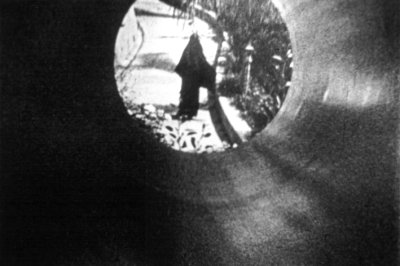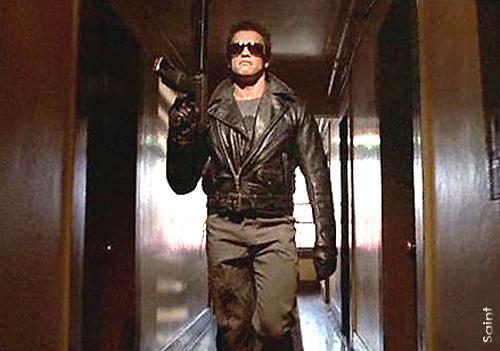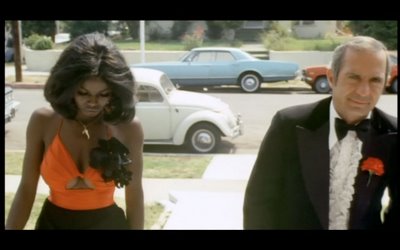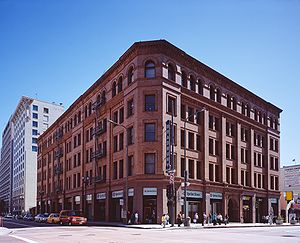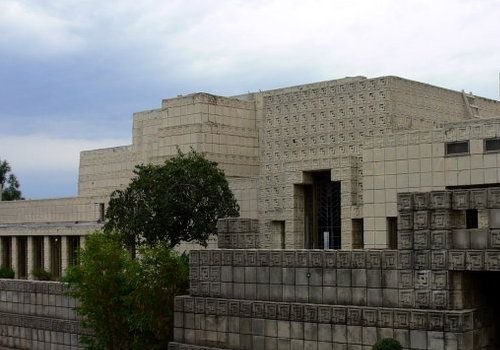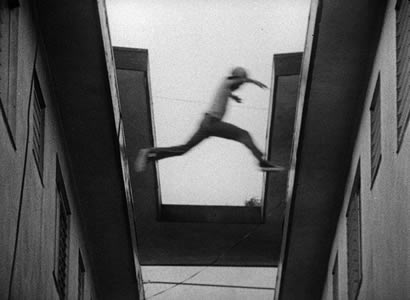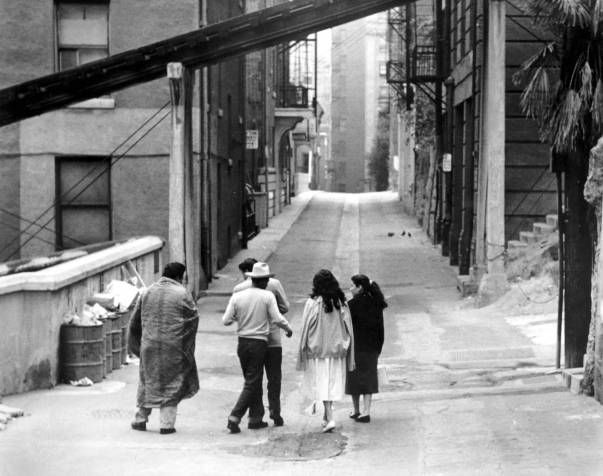From the Chicago Reader (October 1, 2004). — J.R.
Los Angeles Plays Itself **** (Masterpiece)
Directed and Written by Thom Andersen
Narrated by Encke King
I think there’s this weird thing at work now with the way people relate to, specifically, mainstream cinema. When they watch those movies they like to be on the receiving end. . . . The sound is so loud, and the images are so powerful, they want to be totally passive. But then, a few months later, the same film is on DVD, and they can watch it and they own it. And the relationship is inverted. They own that moment, that scene. They also control that diverse, complex relationship they have with film actors. They can watch this or that in slow motion or image by image. — Olivier Assayas in a 2003 interview
The paradigmatic shift in moviegoing described above is fundamental, profoundly altering what we mean by film history as well as film criticism. But if you keep your focus trained on theatrical releases, and regard the subsequent surfacing of the same items on video and DVD only as faint echoes, you’re less likely to be aware of what’s been happening lately, which is in fact affecting the entire corpus of cinema and our access to it. From this more global point of view, the full year that it’s taken for my favorite movie at last year’s Toronto film festival to reach Chicago —- it’s playing now for a week’s run at the Gene Siskel Film Center —- is still only the second stage in a three-step process. The culmination will be when you can take Los Angeles Plays Itself home with you and watch it again at your own speed, as I just did while preparing to write this review.
Thom Andersen’s compulsively watchable, endlessly quotable 169-minute essay film is already a pertinent consequence of this change, because it derives from him reclaiming and mastering his own previous experience of watching movies. Designed specifically to ape an old-fashioned double feature, with an intermission planted about two-thirds of the way through, it lies outside the mainstream because it lacks studio backing and distribution, yet it’s far too plainspoken and witty to qualify as esoteric or marginal. It’s an essay that qualifies as social history, as film theory, as personal reverie, as architectural history and criticism, as a bittersweet meditation on automotive transport, as a critical history of mass transit in southern California, as a wisecracking compilation of local folklore, as “a city symphony in reverse,” and as a song of nostalgia for lost neighborhoods such as Bunker Hill and unchronicled lifestyles such as locals who walk or take buses.
Most of all, it qualifies as film criticism on the highest level —- analytical, transformative, and profoundly political. But it’s also sufficiently engrossing and funny to persuade some viewers that it isn’t being political or seriously critical at all, at least until its closing stretches —- a clever ruse it shares with Ron Mann’s documentary Go Further, an engaging piece of environmental propaganda that also turned up at the Toronto film festival (as well as Chicago’s) last year, and which will open at the Landmark in early December.
Like Los Angeles itself, politics and criticism sometimes need to be disguised or de-emphasized in order to register with effectiveness as entertainment. Such is our tortured ambivalence about fun as well as edification that we virtually demand to be hustled. Curiously, the same subterfuge in reverse is used with certain kinds of mindless entertainment. The sour and unvarying sitcom made out of the presidential campaign by most current TV news coverage can coast along as chewing gum for the eyes and ears with minimal amounts of information only because it carries the pretense that it’s informing us about something vital.
So it might be argued that parts of Los Angeles Plays Itself, even its exemplary simplicity, lightness, and clarity, carry some elements of a con job —- because if Andersen owned up to doing something serious and complex we’d be less likely to pay close attention. The American taboo against discussing class —- brilliantly explored in Thomas Frank’s recent book What’s the Matter with Kansas? —- is part of what necessitates this deception, and the unreasoning conviction that anything that educates us can’t be pleasurable probably accounts for much of the rest.
This mask, which often takes the form of crankiness and sarcasm, also runs the risk of creating a false impression about Andersen’s relation to his material. Though most responses to his film have been enthusiastic and supportive, a few of the smarter critics, such as Gary Indiana and A.O. Scott, have registered piqued demurrals. “Do I really feel superior to Hollywood movies, as A.O. Scott claimed in the New York Times?” Andersen asks in an article in the current Fall [2004] issue of Cinema Scope (where he also offers appraisals of two major films not covered by Los Angeles Plays Itself, Mulholland Drive and Collateral). “I would say that I take them more seriously than someone who has to write about them twice a week can afford to.” Indeed, Andersen has also accurately noted in interviews that virtually all his clips and the ways that they’re edited by Yoo Seung-Hyun convey appreciations of the movies in question, even when the same movies are being tweaked on the sound track. Brandishing his indifference to what passes for both high and low fashion in his academic neck of the woods, he quotes approvingly from both Richard Schickel and Pauline Kael, stomps twice on David Thomson, and has the following to say about Los Angeles’ most chic spokesperson: “Forget the mystical blatherings of Joan Didion and company about the automobile and freeways. They say, `Nobody walks’. They mean, `No rich white person like us walks.’”
You might say that paradoxically he’s a traditionalist who refuses to play by the rules. Significantly, even the boiler-plate “directed and written by” credit that’s traditionally given to auteurs is dispensed with —- as it is in the films of Chris Marker, another essayist who prefers to have his highly distinctive, personal, and literary commentaries spoken by other people on his soundtracks. Choosing, with a deceptive kind of false modesty, to credit himself merely with “research/text/production,” Andersen serves up clips from almost 200 American movies whose only point in common is their being set in Los Angeles, and uses the voice of Encke King to deliver his text about how these movies — and movies in general — have treated his home town. (Though actually born in Chicago, in 1943, he moved to Los Angeles four years later.)
As the film observes early on, Los Angeles is the most photographed city in the world, yet it’s also one of the most invisible, because we usually aren’t supposed to notice it except as “background”: “If we notice the locations, we’re not really watching the story. It’s what’s up front that counts…but what if we watch with our own voluntary attention instead of letting the movies direct us?” For all the offhanded way he and Assayas evoke the revenge of the passive spectator, it isn’t the least of Andersen’s achievements to alter the ways we look at all 191 films he has excerpted, some of which he excerpts more than once –- an assembly ranging chronologically from early silents to the present, and generically from an experimental film like Meshes of the Afternoon (1943) to The Terminator (1984).
***
A good example of Andersen’s criticism at its finest is a single simple sentence about the films of John Cassavetes: “His comedies face up to tragedy and reject it.” What’s startling about this terse observation is that none of Cassavetes’ films, with the possible exceptions of Husbands, Minnie and Moskowitz, and Gloria, has been regarded by critics as a comedy — certainly neither of the films Andersen has chosen to show us brief segments of, A Woman Under the Influence (1974) and Love Streams (1984), though both segments exhibit extreme forms of behavior.
Andersen is onto something both elusive and special about Cassavetes, and if one also starts thinking about Faces (1968) and The Killing of a Chinese Bookie (1974), both of which also have Los Angeles settings, his meaning becomes more apparent. Apart from scattered evidence of comedy in all these films, what’s most comic about them is their dialectical relation to tragedy — the way that they “face up to tragedy” dramaturgically and then “reject” tragedy as a dramaturgical solution. It might be argued that even the compulsive laughter heard throughout Faces functions dialectically, initially as a rejection of comedy that makes it tragic, and finally as a rejection of tragedy that makes it comic.
What, one might ask, has any of this to do with Los Angeles? In a film that has by now moved through three epic chapter headings —- “The City as Background,” “The City as Character,” and “The City as Subject” —- before arriving at this brief interlude towards the end, sandwiched between considerations of Steve Martin’s L.A. Story (1991) and Diane Keaton’s Hanging Up (2000), the relevance of Cassavetes to the ongoing discussion is mainly implied. L.A. Story, though deemed “an honorably failed romantic comedy,” has at least two strikes against it: one is its title, because Andersen has much earlier discoursed at length about why he despises “L.A.” as “a slightly derisive diminutive” (“Only a city with an inferiority complex would allow it”); the other is its racial profiling. (We’re told that there are only “two blacks with speaking parts” in the movie, “both restaurant employees”.) Then the narration adds, “The comedies of John Cassavetes cut deeper,” leading us directly into the aforementioned Cassavetes clips and other comments. And once Hanging Up is gently but firmly skewered for professing to be about Los Angeles while restricting its exposure of public space to a tunnel that the upper-class characters drive through, it becomes clearer that Cassavetes is trusted because he shows us a more comprehensive view of life in Los Angeles in terms of both class and behavior.
***
All cities are palimpsests, just as any historical period is a combination of previous historical periods, and part of Andersen’s modus operandi is to show us why the example of Philip Marlowe continues to have a solid grip on our perception of a layered text such as Los Angeles. A detective’s job is to look at the same surfaces everyone else sees and tease out a formerly unseen layer, and that’s what Andersen does —- not only when he’s showing us clips, but also when he’s generating footage of his own, shot by experimental filmmaker Deborah Stratman, to make some of his points. Early on, we’re shown a series of signs in otherwise unremarkable landscapes directing crews to film locations, and the signs themselves wouldn’t register as such if Andersen didn’t alert us to their covert meanings.
From there it’s only a logical step to introduce us to some of the more famous locations and sites in various films —- including the outdoor steps in Silver Lake navigated by Stan Laurel and Oliver Hardy when they attempt to move a piano in The Music Box (1932); the Spanish colonial revival house occupied by Barbara Stanwyck in Double Indemnity (1944); the Bradbury building at 3rd and Broadway, inspired by Edward Bellamy’s evocation of a socialist utopia –built in 1893 and discovered by movies half a century later, where it plays a Burmese hotel in China Girl (1943), a London military hospital in The White Cliffs of Dover (1944), and eventually, many noirs and SF programmers later, an apartment house of the future in Blade Runner (1982); Frank Lloyd Wright’s Ennis house (1924), in numerous appearances stretching over 66 years, from Female (1933) to a 1999 music video, often with different interiors; and Union Station, a favorite site for movie kidnappings.
The fact that Blade Runner also uses the last two locations, with Union Station doubling as a police station, contributes to Andersen’s investigation of the ways in which reality and fantasy mingle in all the films he cites. Sometimes the sources of reality are as unexpected as the sources of fantasy. A low-budget 1952 programmer called The Atomic City in which we see a real crowd of spectators leaving a baseball game —- a sequence that might have defied the production code’s prohibitions at the time about the “social intermingling of white and colored people” had it employed extras — “suggests that Los Angeles may have been more comfortably integrated in 1952 than it is today.” On the other hand, counter-illustrating Andersen’s biases against films that take geographical license with the city is the “literalist” thriller Kiss Me Deadly (1955), scrupulously respecting every location it uses, even though its plot veers towards science fiction and Greek mythology.
Eventually this develops into a fascinating simultaneous appreciation of modernist architecture in Los Angeles and a caustic denigration of the way it’s invariably used (as in hillside homes designed by John Lautner and Richard Neutra) to house villains in crime pictures. More generally, Andersen often takes the transgressive but defensible position that films are to be valued for what they reveal to us regardless of their own intentions. After noting that cop Joe Friday “thinks like a computer” and “walks and talks like a robot,” the narration confesses, “Actually, I love Dragnet” —- referring to the 1968 TV show more than the 1951 feature, although both are sampled. “Its creator and star Jack Webb directed each episode with a rigor equaled only by Ozu and Bresson, the cinema’s acknowledged masters of transcendental simplicity. Dragnet admirably expressed the contempt the LAPD had for the law-abiding citizens it was pledged to protect and to serve.” And after maintaining that the parade of grotesque crazies in these episodes contributed to the national image of Los Angeles as Cuckooland, Andersen can’t resist asking rhetorically, “Is there any other city that puts its [police force’s] motto {`To protect and to serve’) in quotation marks?”
***
Andersen teaches film and video at the California Institute of the Arts, and Los Angeles Plays Itself grew out of one of his lectures there. But it’s also clear that he’s been storing up material for this feature for most of his life. And it’s important to recognize that one doesn’t have to agree with any of his judgments in order to learn something from them. “People who hate Los Angeles love Point Blank,” he remarks with irritation while ruminating on the subject of “high tourists” and “low tourists” who shoot in Los Angeles. High tourists include Jacques Demy (Model Shop, 1969), Michelangelo Antonioni (Zabriskie Point, 1970), and Jacques Deray (The Outside Man, 1973); low tourists include Alfred Hitchcock (only one of whose 30 American films is set even partially in Los Angeles — the first ten minutes of the 1942 Saboteur), Woody Allen (Annie Hall, 1977), and John Boorman (Point Blank, 1967).
As someone who loves both Los Angeles and Point Blank, I’m not sure what to make of Andersen’s declaration, but at least he helps me to see the grotesquerie of this modernist thriller’s interior decoration in a different light. And when it comes to Robert Altman, the narration is brilliant both in decrying his “condescension towards the outer suburbs” and how his characters “lead lives of noisy desperation” in Short Cuts (1993) and in appreciating how Elliot Gould’s Marlowe in The Long Goodbye (“Altman’s best film,” 1973) serves to deconstruct and expose aspects of the city’s environment.
His two most substantive critiques pertain to two overpraised and underexamined crime pictures that put Los Angeles on the map as a respectable movie subject, Chinatown (1974) and L.A. Confidential (1997). Andersen’s concern is less with how these films misrepresent local history —- though he’s highly informative on this topic in both cases — than with why these misrepresentations have been so widely embraced, and how they’ve functioned ideologically as pretexts for political defeatism: “Cynicism has become the dominant myth of our time and L.A. Confidential preaches it….Cynicism tells us we are ignorant and powerless and L.A. Confidential proves it.”
But in many ways the film’s most touching passage is its last —- a celebration of the neorealist depictions of minorities in Bunker Hill and Watts in four neglected features: the late Kent Mackenzie’s The Exiles (1961), Haile Gerima’s Bush Mama (1975), Charles Burnett’s Killer of Sheep (1977), and Billy Woodbury’s Bless Their Little Hearts (1983). The first of these, about Native Americans from Arizona who’ve emigrated to Bunker Hill, had some currency in the early 60s but has been almost completely forgotten ever since until Andersen revived it. (It has played at a few festivals and other venues alongside Los Angeles Plays Itself, and I can only lament that the Film Center isn’t showing it; as a piece of filmmaking and as a fragrant time capsule, it’s worthy of being placed alongside Cassavetes’ Shadows, which was released the previous year.) The other three are often made to seem as remote from contemporary film culture as Bunker Hill is from contemporary Los Angeles, but Andersen vividly resurrects them with sharp and deeply felt appreciations.
Finally, by changing our relationship to both his title city and the movies filmed there, Andersen alters our options both as moviegoers and as Americans. The very fact that he dares to see a relation between these two identities may be his boldest step of all. If you’re looking for some redemption in either capacity, this film, a monumental act of recovery, is the place to go.


